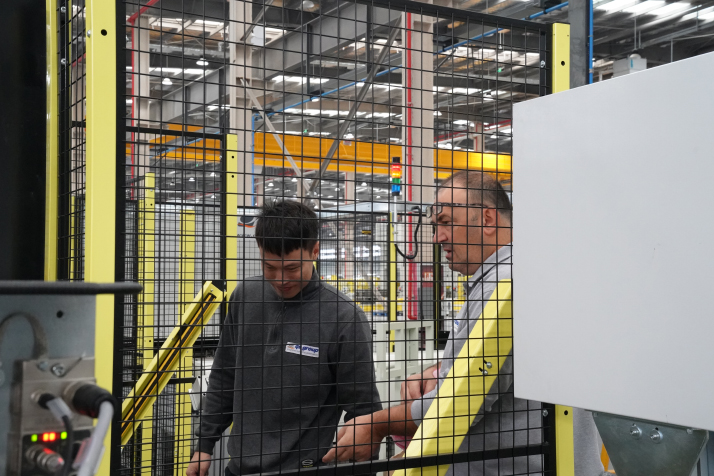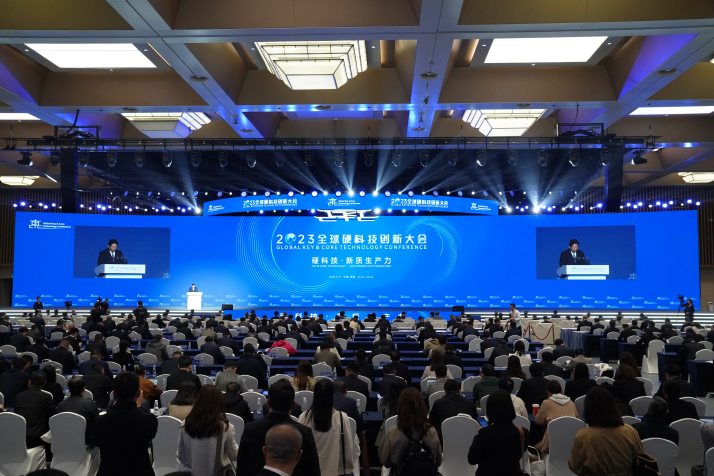| World |
| Xi'an becomes a magnet for international sci-tech professionals | |
|
|
 An employee of Chinese home appliance maker Konka Group talks with his Italian counterpart in Xi'an, Shaanxi Province, on October 31 (ZHANG WEI)
Pramod Kumar Gupta from Nepal now works for CCCC First Highway Consultants Co. Ltd., a highway planning and design institute in Xi'an, Shaanxi Province in northwest China. Having been in China for almost 25 years, he said the city has been the scene of his college graduation, marriage and career. Recalling his memory of Xi'an when he first arrived and comparing it with the city's current development, Gupta described the changes as "tremendous." For example, his alma mater, Chang'an University, is located near the Giant Wild Goose Pagoda, which was first built over 1,300 years ago during the Tang Dynasty (618-907). "The area used to be the outskirts of Xi'an in 1999 and now is a landmark site showcasing the hustle and bustle of the city," he said. Xi'an, once called Chang'an, served as the capital of several imperial dynasties for more than 1,100 years and has long been a hub of East-West cultural exchange and mutual learning. The city was also the starting point of the original Silk Road, which later expanded into a network of East-West trade routes linking Europe with Asia. In 2013, Chinese President Xi Jinping proposed the Silk Road Economic Belt and the 21st-Century Maritime Silk Road, constituting the Belt and Road Initiative (BRI), which aims to boost connectivity along and beyond the ancient Silk Road routes. Adrien Oger Peulvast, a French railway signal expert based in Nanjing, Jiangsu Province in east China, said the initiative is great for connecting people and goods. "And for us, it's a way to share safety in the transportation by adopting same standards and technologies. It's also a way to share experiences between China and European countries," he said. Peulvast was among the international participants in the 2023 Global Key and Core Technology Conference in Xi'an in early November. Peulvast told Beijing Review that he attaches a special emotion to China-Europe freight trains, a flagship project under the BRI, as the terminus of a route is very close to his mother's hometown in Germany. Nowadays, 17 China-Europe freight train routes connect Xi'an with 45 countries and regions in Central Asia and Europe. In the eyes of Abdul Ghani Razaqpur, a world-renowned Canadian scholar in engineering and now a professor at the Tianjin-based Nankai University, "it is the combination of history with modernization that makes the city (Xi'an) unique." Razaqpur, who also attended the conference, added that the miracle of the Terracotta Warriors from the Qin Dynasty (221-207 B.C.) reminds him of Chinese people's determination to complete large or important projects in spite of difficulties.  The 2023 Global Key and Core Technology Conference opens in Xi'an, Shaanxi Province, on November 3 (ZHANG WEI)
Innovation hub Flora Gaetani, an Italian professor of the Polytechnic University of Milan, came to Xi'an for a joint teaching program with Xi'an Jiaotong University one year ago. She has been impressed by the city's historical aspects, particularly the intricate patterns and textures found in its ancient architecture. At the same time, Gaetani said the modern and efficient modes of transportation in Xi'an makes it a favorable place for her to live and work. Cherishing its profound history, Xi'an now is also an international hub with rapid scientific and technological innovation, Gupta said. His comment was echoed by Rasha Khalil, a Syrian scholar working at Sichuan International Studies University in the southwestern province of Sichuan. "While deeply rooted in history, the city is also modern and rapidly developing. It has seen significant economic growth and urbanization in recent decades, with a booming technology and education sector," she said on the sidelines of the conference. On November 3, at the 2023 Global Key and Core Technology Conference, LONGi Green Energy Technology Co. Ltd., a Xi'an-headquartered photovoltaic giant, announced that the efficiency of its proprietary crystalline silicon-perovskite tandem cells reached 33.9 percent, setting a new global record, according to the latest certification report from the National Renewable Energy Laboratory of the United States. Key and core technology refers to advanced cutting-edge original technologies, encompassing artificial intelligence, aerospace, bio-technology, photonic chips, information technology, new materials, alternative (new) energy and intelligent manufacturing. "Xi'an's output of new-energy vehicles accounts for more than 11 percent of the national total, its semiconductor industry ranks fourth in the country, and locally manufactured memory chips and single-crystalline photovoltaic cells have the largest market share worldwide," Fang Hongwei, member of the Standing Committee of the Communist Party of China (CPC) Shaanxi Provincial Committee and Secretary of the CPC Xi'an Municipal Committee, said at the conference. The conference, which also unveiled the city's major sci-tech breakthroughs, is vital for researchers. They can find elements there that will help them move forward in their research and activities, according to Razaqpur. Xi'an is a fine example of Shaanxi's sci-tech advancement. Over the past three years, the province has seen an average annual increase of 31.8 percent in technology contract transactions, 40.6 percent in the number of technological small and medium-sized enterprises, and 40.3 percent in the number of hi-tech enterprises. From January to September this year, the number of newly registered technological startups in the province reached 17,254, 8 percent more than the total for 2022, Wang Xiao, Executive Vice Governor of Shaanxi, told the conference. Cooperation holds the key According to Ukrainian geo-physicist and radio-physicist Leonid Feoktistovich Chernogor, who currently works at the College of Electronics and Information at Qingdao University in the eastern province of Shandong, China has experienced rapid development in cutting-edge research and the integration of advanced fundamental research with applied technologies. "These elements have laid the groundwork for China to become a global center of sci-tech innovation in the future," he said while in Xi'an for the conference. Piotr Breitkopf is a researcher at the French National Center for Scientific Research and a visiting professor at Northwestern Polytechnical University (NPU) in Xi'an. His collaboration with research teams at NPU dates back 20 years, and he has been instrumental in establishing cooperative platforms and international research centers that further collaboration. Cooperation at a personal level is beneficial, but having an organized framework may allow multiple parties to come together effectively, Breitkopf said. For instance, international conferences and seminars can play an important role in gathering professionals from diverse backgrounds and places. "Science is international and there is no good science going on without international cooperation. This is not a local event, but something where a lot of people work together," Helmut Kettenmann, a German professor at the faculty of life and health sciences at the Shenzhen Institute of Advanced Technology in the southern province of Guangdong, said at a foreign experts symposium on the sidelines of the conference. "It is crucial for people from different countries and regions to engage in dialogue and provide feedback," he added. "Xi'an has been working to create an attractive and accommodating environment that allows overseas professionals to unleash their potential with comprehensive services, and to increase what we like to call the 'Xi'an magnet' for international scientists," Lou Wenxiao, Deputy Director of Xi'an Municipal Science and Technology Bureau, said at the conference. Additionally, as part of its efforts to promote global scientific and technological exchange, Xi'an has established 154 international sci-tech cooperative bases and set up six overseas sci-tech working stations in countries including Singapore and Germany, Lou added. The city will become a fertile ground for international cooperation and exchange because it possesses vast resources and potential, according to Peulvast. (Printed edition title: History and Modernization) Copyedited by G.P. Wilson Comments to mamm@cicgamericas.com |
|
||||||||||||||||||||||||||||||
|
